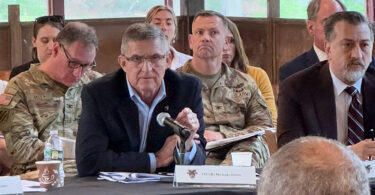By James Hasson, former Army Captain and Afghanistan veteran | The Federalist
(STARRS NOTE: This article is from July 2017 shows the madness has been going on for sometime)
On June 30, hours before the policy took effect, Defense Secretary Jim Mattis postponed the opening of military enlistments to transgender people for an additional six months. The delay does not prevent currently serving soldiers from transitioning, however. It is intended to give the joint chiefs more time to review and mitigate the Obama-era rule’s impact on the “readiness and lethality of our [armed] forces.”
Late into President Obama’s last term, his military officials allowed transgender soldiers to serve openly, even funding gender-change surgeries with taxpayer dollars. Former Defense Secretary Ash Carter set a July 1 deadline for all four military branches to write policies for accepting openly transgender enlistments. Formerly, soldiers exhibiting gender dysphoria were automatically discharged.
While the Pentagon’s review takes place behind closed doors and the inevitable culture-war volleys spill into the public square, it is critical to understand the real-life implications of the policy shift.
I recently received a copy of the new “Tier Three Transgender Training” materials—a PowerPoint and accompanying lesson plan excerpted below, with full documents at these links—that the Army is now using in mandatory training for all soldiers.
The active-duty officer who sent the materials completed the training with 40 other soldiers last week instead of conducting their morning physical training as usual.
Military As Social Engineering, Not National Defense
The force-wide presentation sheds quite a bit of light on the implications of the rule change on transgender service members.
The policy prioritizes subjective feelings over combat-readiness and inverts military order by placing the needs of individuals over the well-being of their units.
The policy allows transgender soldiers to switch their “gender marker” in the Army’s personnel database without undergoing sex reassignment surgery or any other physical changes.
For a soldier to officially change gender requires only some paperwork.
A military doctor or civilian medical professional must certify that the transgender person has achieved “stability in the preferred gender” and the soldier must change the gender designation on the soldier’s passport or birth certificate.
From that point on, the transgender soldier is “expected to adhere to all military standards associated with their gender,” and “use the billeting, bathroom and shower facilities” of their new gender.
For example, “Vignette Four” of the training module presents the following scenario:
“following her transition from male to female (which did not include sex reassignment surgery) and gender marker change in DEERS [DEERS is the military’s personnel database], a transgender Soldier begins using female barracks, bathroom and shower facilities. Because she did not undergo a surgical change, the Soldier still has male genitalia.”

The slide tells soldiers to “understand that you may encounter individuals in barracks, bathrooms, or shower facilities with physical characteristics of the opposite sex despite having the same gender marker in DEERS.”
The next bullet point adds, “all Soldiers should be respectful of the privacy and modesty concerns of others. However, transgender Soldiers are not required or expected to modify or adjust their behavior based on the fact that they do not ‘match’ other Soldiers.”
This is a first. The military is normally in the business of telling soldiers to “modify or adjust their behavior” all the time.
Consider what these policies mean in real life:
Most Army showers look like a prison cell with several showerheads on the wall. Anyone who has dealt with the practical challenges of funneling 30 people through them in ten minutes understands that “privacy” will be incompatible with reality.
Female soldiers who feel uncomfortable sharing facilities with individuals who still have “physical characteristics of the opposite sex” will just have to put up with it.
The adjustments to “billeting” are equally intrusive.
Modern barracks resemble college dorms, with two soldiers of the same sex — now “gender marker” — sharing rooms just large enough to accommodate the basic necessities of military life.
The training forbids any commander from ordering a transgender soldier to use a facility that is inconsistent with his “gender marker,” and rejects the idea of separate facilities for transgender soldiers.
If separate facilities of any kind are created, they must be for soldiers who feel uncomfortable sharing facilities with a member of the opposite biological sex.
In short, the rest of the unit must adjust, not the individual transgender soldier.
Watch My Genitals While I Urinate
The changes also affect drug-testing procedures. DoD Instruction 1010.16 requires urine specimens to be “collected under the direct observation of a designated individual of the same sex as the Service member providing the specimen.”
To be blunt, “observers” must watch the urine sample leave the tested soldier’s body and enter the collection cup.
Under the new rules, however, “absent an exception to policy, the observer will be the same gender as the Soldier being observed (as reflected by the gender marker in DEERS).”
The change is justified by interpreting the term “sex” in existing drug testing regulations to mean the same thing as “gender.”
Lest there be any confusion: the policy means that an 18-year-old female soldier may be forced to drop her pants and urinate in a cup in front of an anatomically male non-commissioned officer who has a female “gender marker,” and vice versa.

As important as privacy and respect are, the biggest problem with the policy is its effect on the military’s core purpose of battle readiness.
For example, under the policy, a male infantryman who cannot meet the bare minimum requirement of 42 pushups and is therefore considered a liability in combat can switch his “gender marker” to female and suddenly be qualified.
Even though he retains the exact same physical characteristics, and can do only 19 push-ups, he will now be a combat-ready female infantry soldier, eligible to hold the exact same role in his former unit.
The lesson plan is explicit on this point: “for policies and standards that apply differently to Soldiers according to gender, the Army recognizes a Soldier’s gender by the Soldier’s gender marker in the Defense Enrollment Eligibility Reporting Systems (DEERS).”
Bullets Don’t Care About Your Feelings
Regardless of one’s opinion about bathroom bills, this policy is dangerously misguided not because of politics or ideology, but as a matter of basic physics.
Biology may not be destiny, as the slogan goes, but it still matters on the battlefield.
An AK-47 round travels towards a soldier at 2,330 feet per second, no matter how you self-identify. A six-foot tall, 180-pound, anatomically male soldier can either pull his bodyweight over a wall, or carry another soldier, or walk for miles with 80 pounds of equipment, or he cannot.
But under the current policy, you are combat-ready if you self-identify as the type of person who would be combat-ready. How very millennial.
Of course, the new policy raises other logistical issues as well.
If “stability in the preferred gender” does not preclude ongoing hormone therapy, will these soldiers be deployable? Should estrogen cycles be flown into remote forward operating bases with other critical medical supplies?
And if these soldiers cannot deploy alongside their units, is the policy truly serving its stated goal of availing the armed services with “all available talent to remain the finest fighting force the world has ever known”?

The “harassment and discrimination” section of the lesson plan forbids “attitudes or comments that marginalize transgender people.”
Heated, time-sensitive situations come with enough confusion on their own, without the additional layer added by gender-neutral pronouns such as “they” and “their,” and soldiers should not have to double-clutch for fear of repercussions before speaking bluntly in such situations.
The military has always been at the forefront of civil rights and equality in our society, and that should never change.
But this policy is not a question of equality, it is a matter of basic safety and combat effectiveness.
It asks the other 39 soldiers in a transgender soldier’s platoon to potentially sacrifice their safety for one soldier’s affirmation.
t is the inverse of the traditional military ethos.
On one of my first days in the Army, I listened to a non-commissioned officer tell a new private, “Words don’t hurt — bullets hurt. So I don’t give a . . . about your . . . feelings.” (Creative language omitted.)
Master Sergeant Wood was a veteran of the Gulf War and Operation Iraqi Freedom, a Purple Heart recipient, and had only four fingers on his right hand. He knew the truth of his statement from firsthand experience.
It seems somewhere along the line, during the last 15 years of war, our political class lost track of his most basic insight: Words don’t hurt. Bullets hurt.








Leave a Comment